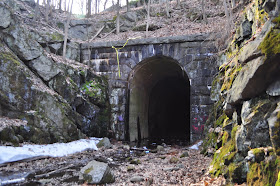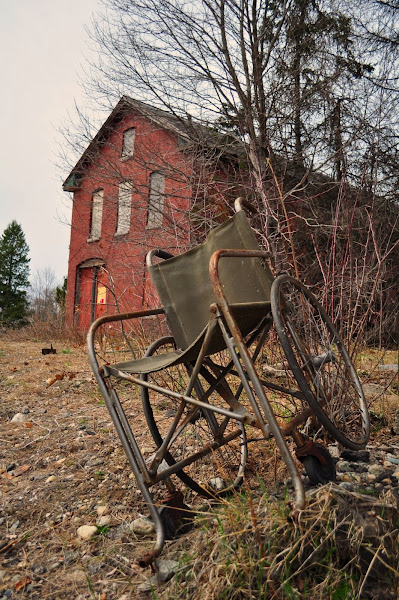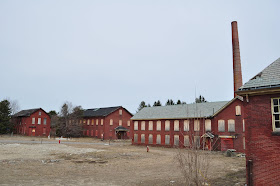This winter, I visited the Old Stone Church in West Boylston. Communities along the Nashua River had changed completely after the Wachusett Dam was filled in 1908; I became interested in the landscape before the reservoir was filled.
After I visited the Wachusett Dam, I walked down Boylston Street for a good few minutes to a disused train tunnel. On the street level I only found a stone foundation, I looked up and found something like a portal. I decided to climb up a bit.
I was wondering about stone foundations at the basin, it looked like a remain of a bridge. But what kind of bridge? When I was on top of the portal, it was clear that the tunnel and stone foundations in the water were aligned, so those remains were for the railroad bridge.
I first thought the tunnel was abandoned due to the completion of the Wachusett Reservoir in 1905. On the contrary, the tunnel and railroad were built to replace the line impounded by the reservoir. The tunnel was completed sometimes around in 1903 as a part of the Central Massachusetts Railroad. This 0.2 mile (340m) long tunnel was the second longest tunnel* in the state of Massachusetts when it was constructed. The line became disused in 1958, and the railroad tracks and bridge were cleared. But the tunnel goes through the Wilson Hill still remains.
*The longest tunnel in the state was the 8.5 mile (14km) long Hoosac Tunnel completed in 1875.
Photo taken in 1902: from Waymarking.com, posted by Downy288
Is it okay to enter or not: that was the question. I saw an article about an off-duty police officer exploring the tunnel with his kids for fun. A local resident suggests calling the Clinton police department before exploring the tunnel during the night, so the police will make sure you are all right. But keep in mind; there is a local rumor that a missing girl's body was found in the tunnel some 30 or 40 years ago...
Photo taken in late March
I recommend bringing a flashlight and wear a good pair of waterproof boots, or you'll end up tripping on giant ice pillars like above.
The giant ice does look like a ghost, classic Casper type; there is a handful of ghost stories and urban legends linked to this tunnel. Possibly many of the stories were from the fear that the girl's body might be found in this very place. The darkness, amplified sound, and cold atmosphere are the prefect setting for inducing some scary visions. I only learned about the girl's body after I explored, but I must have read the story before hand. It means I had blocked the information out from my brain!
The most popular paranormal legend is one experiences the tunnel stretches out, looks like the other portal is in an infinite distance. But after experiencing the stretching stone steps at the Wachusett Dam, it was nothing; I reached the other portal in 5 minutes, it was on the longer side of the notion of 5 minutes, but far better than climbing up the steep stone steps for 5 minutes.
I also heard some strange mechanical sound inside, and found out it was the one of a chainsaw from somebody's house. Not the TX massacre type but the Saturday DIY type, the amicable one.
I examined the tunnel interior. The paved concrete only continues for a short distance; after that, it's a bare granite rock. I could imagine the labors 100 years ago igniting dynamites and drilling through the tunnel leaving the rough surface. Looking at the bare tunnel surface, I began worrying about the tunnel cave-in while I was going back to the other portal. Going is always easy, but returning is another story.
While I was going back, a series of bizarre incidents I had experienced in my life came up to my mind. A lady who "dropped" a jam jar from 4th floor while I was walking right under. A guy hired me as a photographer asking to take portraits of his colleague who didn't know she's going to die from cancer soon. Infirm, frail old widows by the Ganges begging money for fire logs.
I looked back for no reason and remembered the descent to the Underworld of Orpheus. I shouldn't look back because Orpheus failed to bring his dead wife to this world by doing so. It's just a bad thing to do in the dark.
I came out safe and alive, a pick up truck with thundering bass sound passed by Boylston Street. I could hear the booming sound even the truck was on the other side of the reservoir.
Continue to: Wachusett Aqueduct
Locate Clinton Tunnel @ Google Map
1943 map of Clinton, Mytopo Historical Map: http://historical.mytopo.com/getImage.asp?fname=clnt43se.jpg&state=MA
Haunted Clinton tunnel appears endless, Worcester Telegram & Gazette: http://www.telegram.com/apps/pbcs.dll/article?AID=/20060807/NEWS/608070345/1003/NEWS03#
Tunnel Vision, New England Oddities: http://newenglandoddities.com/2008/05/19/tunnel-vision/#more-62



















































